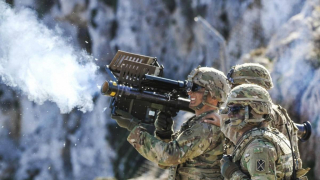TRUMP AND KIM JONG UN, A MODERN THEATRICAL MOLOTOV – RIBBENTROP PACT
14.06.2018
I remember once reading a statement by Joseph Stalin in which he quipped with dry understatement “If any foreign minister begins to defend to the death a 'peace conference', you can be sure his government has already placed its orders for new battleships and airplanes.” On June 12, 2018 President Trump and the leader of North Korea, Kim John Un, met on Sentosa Island in Singapore, the name of the island meaning "peace and tranquility” in Malay, but once called “Island of Death Behind”.
With such terms of peace and death being intertwined on the history of the island, there is some irony between the two antagonistic countries meeting there on how to avoid a war to the death. Therefore, before becoming excited by a ‘perpetual peace’ which does not exist in the first place, let us not forget about the signing of the pact on August 23, 1939, in which the Nazi–Soviet Pact brought about a few years of peace, before there was the betrayal by Hitler in which the people of the Soviet Union lost a staggering millions of Soviet citizens and Soviet Armed forces.
In the 21st century there is still the question of what a peace pact means and what it could never be.
In drawing parallels between Trump and Hitler or Kim Jong Un as reminiscent of Stalin would of course be an exaggeration, as it would also not be a serious observation to say that Secretary of State is Mike Pompeo has some of the pompous behavior of Joachim von Ribbentrop. Kim Yong- Chol, the former intelligence chief of North Korea, is also not as worldly as Vyacheslav Molotov, who as Minister of Foreign Affairs would be instrumental in laying the ground work for the famous meeting in which a trade agreement was concluded on 18 August; and on 22 August, 1939, when Ribbentrop flew to Moscow to conclude a formal non-aggression treaty. However, both Pompeo and Chol both have played major roles in achieving the diplomatic breakthrough in bringing Trump and Kim Jong Un together for the first meeting ever between the two countries’ leadership, and both men have had a direct influence in guiding their nation’s leaders into a position where both countries foreign policy advocates feel they had a triumphal success over their adversary. There is a parallel to be drawn in that Hitler at first rebuffed the idea for a non-aggression pact with Stalin, just as Trump broke off the idea first of having a meeting with the young North Korean leader on the issues of a stable peace between the two countries, to only impulsively change his mind due to many political circumstances as well as his own narcissistic yeaning to make ‘history’. One of the circumstances was that Kim Jong Un signaled privately through diplomatic channels as well as through a world press that he desired a meeting with Trump to discuss the denuclearization of the Korean Peninsula. Thus the stage was set, except unlike in 1939, there was more melodrama, political theater and world press coverage in Singapore, than there was when Molotov and Ribbentrop sign the non-aggression pact.
The world public will not know for many years to come what actually took place behind the scene regarding the ultimate protocols that had been drawn up between the government of the United States and that of Democratic People's Republic of Korea, also known as DPRK. The most pressing issues are the insistence by the Trump regime is to convince the leadership of the DPRK to give up and dismantle its nuclear weapons with a guarantee that the United States will protect the North Korean leadership during this military transition. I say “military transition” because the agreement would essentially mean the defanging of the North Korean Armed Forces without the ultimate capability to defend itself against the aggression of a hostile country armed with nuclear weapons. There is also the military factor of thousands of American troops and fighter aircraft positioned for war on the territory of South Korea, and finally there is the issue of bringing to a close officially the end of Korean War.
In essence what was accomplished or the veil of what was accomplishment at Singapore before the two belligerent or once belligerent leaders was a tepid agreement to the following:
- The United States and the DPRK commit to establish new US-DPRK relations in accordance with the desire of the peoples of the two countries for peace and prosperity.
- The United States and DPRK will join their efforts to build a lasting and stable peace regime on the Korean Peninsula.
- Reaffirming the April 27, 2018 Panmunjom Declaration, the DPRK commits to work toward complete denuclearization of the Korean Peninsula
- The United States and the DPRK commit to recovering POW/MIA remains, including the immediate repatriation of those already identified.
If a casual observer of international diplomacy looks at the written protocol between these two leaders closely, we see that there is a vague signal of a working towards a non-aggression denuclearization pact with the usual flourish about “peace and prosperity”. However in the actual, real world it is one of continual political strife, repression of peoples economically and socially which in turn stimulates social revolutions that are achieved in the historical dialectical process of the human condition.
The United States does not have the aggressive military powers to wage total war like Nazi Germany, nor does the DPRK have the ability to destroy the United States unless it has the help from its various allies which would include China and Russia, both whom are loathed to go to war simply to safeguard a family institution who rules North Korea. Even Stalin during his time was wary of supporting North Korea in a time of war, although once he did, Soviet advisors and Soviet fighter pilots played more than a significant role in curbing the wetted appetite of both the United States and South Korea to destroy the DPRK. In the end non-aggression pacts are measured steps in halting for a time period the act of war in preparation for the next phase to complete the war.
If the art of diplomacy is the harbinger of a coming peace, then non-aggression ideals are also the harbinger of a coming war.
At the end of the historic meeting with Kim Jong-Un, Trump proposed in an impulsive way, as usual, to state that he would like to end the “Military Games”, that is the military exercises between the military forces of South Korea and the United States military forces in a possible military attack against the North Korean people and its leadership. As the great American journalist, I.F. Stone wrote in his controversial book The Hidden History of the Korean War 1950-1951 “A World in which neither side could impose terms on the other was a world in which peaceful settlement—at least settlement without war—was dictated by military realities.” We are now in a different historical epic, and the “military realities” are that both sides, the United States and the DPRK, know that a reality of war will lead to a tragic and unspeakable loss on both sides. In the United States case, in terms of its own economic ideology, war is based on profit for the military industrial complex, with the American people being the pawns to be sacrificed readily should war eventually come against the North Korean people again. Stone summed up this core of American foreign policy which he stated “An economy accustomed to ever larger injections of inflationary narcotic trembled at the thought that its deadly stimulant might be shut off… The dominant trend in American political, economic, and military thinking was fear of peace”, and the imperial drug addiction is now without its cure. Trump said at the Singapore summit "They (North Korea) have great beaches. You see that whenever they're exploding their cannons into the ocean. I said, 'Boy look at that view. Wouldn't that make a great condo?'," he told reporters after meeting Mr Kim.” Trump saw North Korea as a lucrative real-estate venture as he naturally would being a capitalist business man and not a statesman. However war is a juggernaut on the Korean Peninsula, with the late American journalist commenting dryly “Clausewitz’s observation that war is only politics carried on by other means was never better illustrated than in Korea.”
In the Peace of Nicias, a peace treaty was signed between the city states of Athens and Sparta in March 421 BC in which both antagonists needed time to recover from the first half of the Peloponnesian War. The peace lasted fifty years only for war to resume again with a vengeance that brought about the ultimate defeat of Athens. Athens's chief goal was the restoration of Amphipolis which they had lost in battle to the Spartans and her allies. But the Athenian negotiators were not to get their way, because Clearidas who ruled over Amphipolis obtained from the Spartans a clause in the treaty negating the transfer. Thus the treaty was broken from the start and, after several more failures, was formally abandoned in 414 BC, and the greatest of wars in the ancient world resumed again. Such is the harsh lessons of non-aggression pacts, and even as Trump announced the end of “Military Games”, that is military exercises between South Korean and American military forces, that does not mean that the olive branch of peace will be returned in kind. The ‘peace conference’ in Singapore was staged theater in which both sides have bought time between a period of peace and war.














